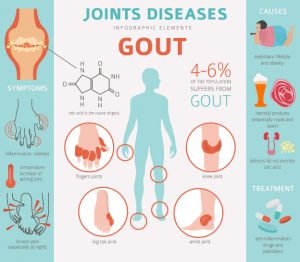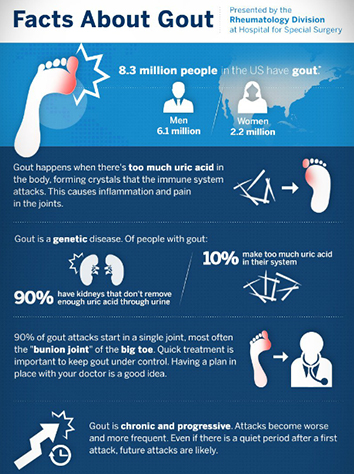
A gout overview explains the different stages of the disease. The first stage is acute and is characterized by acute pain, swelling, and red-purple skin. It can also lead to tophi, or tophi-like lumps in the joints. Eventually, gout attacks can affect more than one joint, and they may not end. Once an attack has begun, the affected joints are usually very painful, swollen, and warm. They may also limit range of motion.
A gout overview includes a description of the causes, symptoms, and treatment. If left untreated, gout can lead to chronic joint complaints, deformities, and tophi, which are masses of uric acid crystals underneath the skin. These masses can appear as white, yellow, or red nodules, and in some cases, they may be very painful. Ten to fifteen percent of patients develop tophi that are disfiguring or even painful, and some sufferers have needed to have their fingers amputated.
The best treatment for gout depends on the type of treatment. Some people are more susceptible to gout than others, and some treatments are not recommended for all people with the disease. The best treatments depend on a person’s condition, and gout is a chronic condition. To determine which treatments are most appropriate for your condition, consult with your doctor or healthcare professional. However, there are no definite guidelines regarding the duration of treatment, and you should consult a health professional if you’re unsure whether a medication is right for you.
During an acute gout flare, tophi crystals can block normal joint function. If left untreated, tophi crystals can destroy bone or cartilage in the affected joints, leading to further deformities. Early attacks of gout are usually intermittent. Once the tophi crystals reach the bones, they can begin to damage them. As the condition progresses, the intervals between outbreaks become chronic.

The disease is associated with several different types of chronic pain, but the most common are pain, swelling, and severe joint tenderness. It most commonly occurs on the big toe, but can also occur on the knees and ankles. It usually starts with severe pain and discomfort, especially at night, but can affect other parts of the body as well. The onset of symptoms may be painful and the skin around the joint may be red. The affected joint may restrict movement. Other forms of gout can also lead to nodules on the elbows, hands, and ears.
An overview of gout may also include symptoms and treatments. Gout medications available for chronic rheumatoid arthritis are often very effective. The goal of gout treatment is to lower blood uric acid levels to less than 6 mg/dL. However, this is not an exact science. Although many people have high uric acid levels, it is important to note that high uric acid levels can cause severe pain and damage. Thus, a warm blood stream rich in urea reduces the risk of rheumatoid arthritis.
The overview of gout in The Kelly Manual of Rheumatology is a brief overview of the causes of the disease and treatment options. Experts from the John M. Eisenberg Center for Clinical Decision and Communication Sciences at Baylor College of Medicine have published a study on gout management that outlines the factors involved in the disease and how it affects patients. This article describes the most common risk factors associated with gout and provides an overview of the condition of gout.
There are several ways to deal with gout. Regular exercise and maintaining a healthy weight are the best ways to fight gout. You should exercise regularly and do your best to avoid rapid weight loss, as this will raise your uric acid levels. In addition, you must stay well hydrated to avoid further complications and complications associated with gout. These dietary changes may also help your condition. For a more complete overview of gout, consider reading the article on the author’s site Anuman Saelim.
The researchers who wrote this report conducted a survey of 43 patients with gout. Their findings are important for both patients and doctors. Although alcohol is an obvious danger, it is not the only factor that causes gout. It is not known whether drinking alcohol is a good idea. Some studies have shown that alcohol can worsen gout symptoms. But others suggest that drinking wine may be beneficial. But the effect of wine on this condition has not been proven.